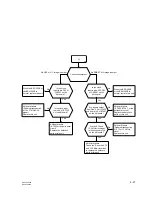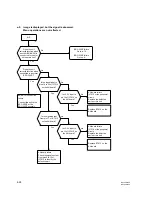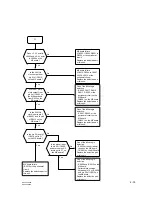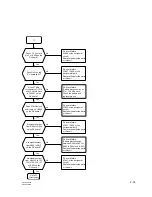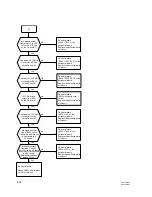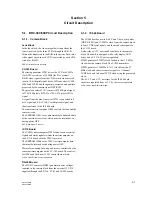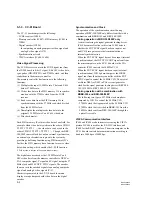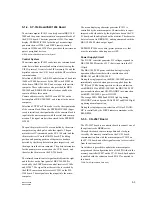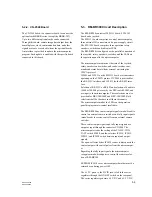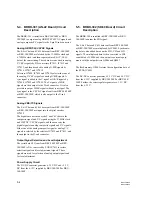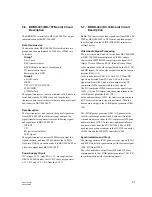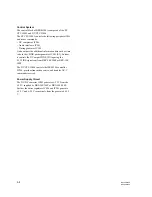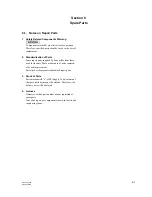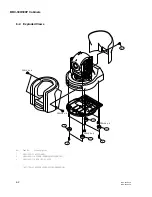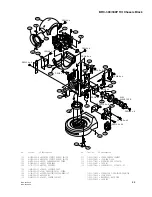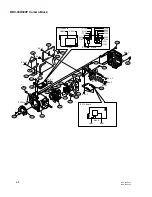
5-4
BRC-300/300P
BRU-300/300P
5-2. BRU-300/300P Circuit Description
5-2-1. MC-66 Board
The MC-66 board is the core board of BRU-300/300P.
Optical Communication Interface
The laser transceiver unit receives camera image data, sync
signals, character data, several clocks (54, 27, 13.5, and
6.75 MHz), and serial control data transmitted from the
BRBK-303 installed in BRC-300/300P through an optical
fiber cable, and then converts the optical signal to electri-
cal signals. Then the gigabit transceiver IC4401 converts
the serial electrical signals to parallel signals. Next, the
demultiplexers IC4407 to IC4412 decodes multiplexed
signals to restore camera signals.
The gigabit transceiver converts clock and control signals
generated in BRU-300/300P to serial signals, and the laser
transceiver unit converts electrical signals to optical signal.
The converted optical signal is then transmitted to the
BRBK-303 in BRC-300/300P with an optical fiber cable.
Video Signal Processing
The digital encoder IC3018 encodes restored 13.5 MHz
rate Y data and CbCr data to composite, Y and C signals
using the 27 MHz clock and H SYNC/V SYNC signals,
and then converts the digital signals to analog composite,
Y and C signals.
IC3018 also superimposes the character data (generated in
BRC-300/300P or by IC3506 on this board) with video
data for menu display.
Synchronization and Clock
IC3001 detects whether the EXT SYNC signal has been
input or not, and lets the signal generator locking driver
IC3009 recognize external synchronization or internal
synchronization.
When the EXT SYNC signal has been input (external
synchronization), IC3009 phase-compares the H REF
signal sent from BRC-300/300P with the EXT SYNC
signal to control the 54 MHz VCO X3001. The crystal
oscillator X3003 (or X3002 in PAL system) generates
clock for the signal generator locking driver (BRU-300:
14.31818 M Hz, BRU-300P: 14.1875 MHz).
When the EXT SYNC signal has not been input (internal
synchronization), the microcomputer IC3518 and the INT
VCO CONT signal sent from the D/A converter IC3008
control the 54 MHz VCO X3001.
The 54 MHz VCO output is used as the clock of the
gigabit transceiver IC4401. The BRBK-303 in BRC-300/
300P restores 54 MHz clock as the reference signal of
BRC-300/300P from the signal that is input through an
optical fiber cable.
The NTSC/PAL mode setting switch S3001-2 is set for
BRU-300 or BRU-300P. The NTSC/PAL switching signal
is sent to the digital encoder, microcomputer, BRBK-301,
BRBK-302, and BRBK-304, as well as to the sync signal
generator circuit for setting a BRU-300/300P operation
mode.
Control System
The microcomputer IC3518 sends/receives commands and
status data to/from internal and external circuits using the
VISCA protocol. It controls the digital encoder on the MC-
66 board with the IIC serial data communication.
IC3512 and IC3514 are transceivers operating on the
VISCA protocol. IC3512 is used for the RS-232C interface
and IC3514 for the RS-422 interface. The microcomputer
controls data communication according to baud rate of
9600 or 38400 bps. Selection of RS-232C or RS-422 and
selection of baud rate (9600 or 38400 bps) are set by the
DIP switch on the SW-1207 board, and are input to the
microcomputer. These selections are also provided for
BRC-300/300P and RM-BR300. Both selections shall be
the same in all these three units.
Camera address is also set by the same DIP switch, and is
input to the microcomputer.
The menu displaying character generator IC3506 is
controlled by the microcomputer. The character data is
superimposed with video data by the digital encoder.
EEPROM IC3501 saves data (preset position, etc.) that
must be retained even during power OFF.
Power Supply Circuit
The AC-DC converter generates
+
12 V DC from the AC
power that is input into the AC inlet, and supplies the
+
12 V DC to the MC-66 board.
The DC-DC converter IC4001 on the MC-66 board
generates DC voltages required in BRU-300/300P.
The PWRC CAM signal, which is the BRU-300/300P
startup information, set the optical output of the laser
transceiver unit to ON/OFF for drive BRC-300/300P into
the ON/STANDBY state in conjunction with BRU-300/
300P.
The POWER indicator (LE-281 board) on the front panel,
which is controlled by the microcomputer, shows power
condition. It lights up in green during normal operation,
and flashes in red when an error occurs.


